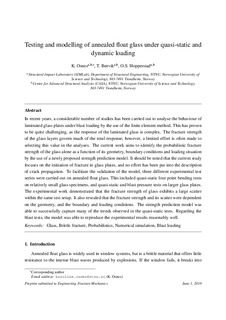| dc.contributor.author | Osnes, Karoline | |
| dc.contributor.author | Hopperstad, Odd Sture | |
| dc.contributor.author | Børvik, Tore | |
| dc.date.accessioned | 2018-06-05T11:10:09Z | |
| dc.date.available | 2018-06-05T11:10:09Z | |
| dc.date.created | 2018-06-04T15:01:40Z | |
| dc.date.issued | 2018 | |
| dc.identifier.issn | 0013-7944 | |
| dc.identifier.uri | http://hdl.handle.net/11250/2500329 | |
| dc.description.abstract | In recent years, a considerable number of studies has been carried out to analyse the behaviour of laminated glass plates under blast loading by the use of the finite element method. This has proven to be quite challenging, as the response of the laminated glass is complex. The fracture strength of the glass layers govern much of the total response; however, a limited effort is often made to selecting this value in the analyses. The current work aims to identify the probabilistic fracture strength of the glass alone as a function of its geometry, boundary conditions and loading situation by the use of a newly proposed strength prediction model. It should be noted that the current study focuses on the initiation of fracture in glass plates, and no effort has been put into the description of crack propagation. To facilitate the validation of the model, three different experimental test series were carried out on annealed float glass. This included quasi-static four point bending tests on relatively small glass specimens, and quasi-static and blast pressure tests on larger glass plates. The experimental work demonstrated that the fracture strength of glass exhibits a large scatter within the same test setup. It also revealed that the fracture strength and its scatter were dependent on the geometry, and the boundary and loading conditions. The strength prediction model was able to successfully capture many of the trends observed in the quasi-static tests. Regarding the blast tests, the model was able to reproduce the experimental results reasonably well. | nb_NO |
| dc.language.iso | eng | nb_NO |
| dc.publisher | Elsevier | nb_NO |
| dc.title | Testing and modelling of annealed float glass under quasi-static and dynamic loading | nb_NO |
| dc.type | Journal article | nb_NO |
| dc.description.version | submittedVersion | nb_NO |
| dc.source.journal | Engineering Fracture Mechanics | nb_NO |
| dc.identifier.doi | 10.1016/j.engfracmech.2018.05.031 | |
| dc.identifier.cristin | 1588846 | |
| dc.description.localcode | This is a submitted manuscript of an article published by Elsevier Ltd in Engineering Fracture Mechanics, 28 May 2018 | nb_NO |
| cristin.unitcode | 194,64,45,0 | |
| cristin.unitname | Institutt for konstruksjonsteknikk | |
| cristin.ispublished | false | |
| cristin.fulltext | preprint | |
| cristin.qualitycode | 1 | |
